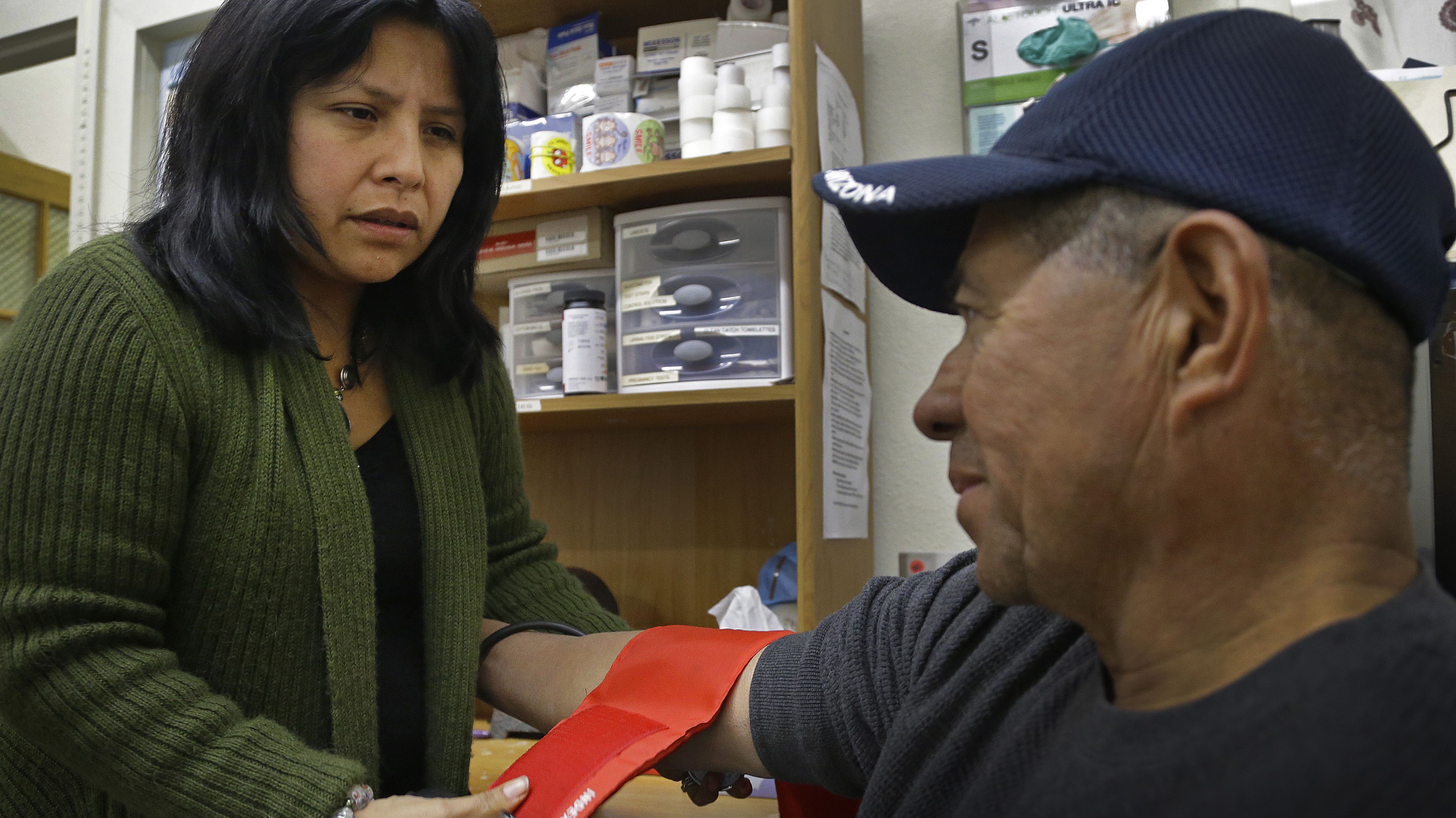Earlier this year, Dr. Joaquin Arambula, an emergency room physician from Selma, became the first Latino physician to serve in the State Assembly after being elected to represent the state’s 31st District — a central California agricultural region where the population is nearly 70 percent Latino.
Arambula says he ran for office partly because of the rapidly growing influx of Spanish-speaking patients in his emergency department. He sought reinforcements, “but there aren’t enough doctors with the cultural competency and understanding of the Latino community” to serve this growing population, Arambula says.
“This is something that needs to change,” he says.
Arambula and members of the Latino Physicians of California, a professional group that seeks to boost the number of Latino doctors in the state, spoke to reporters last week about the need for more representation of Latinos in the medical field.

Laura Lopez, left, checks the blood pressure of Santos Aguilar at the Street Level Health Project in Oakland, Calif. (AP Photo/Ben Margot)
Latinos make up about 40 percent of the population in California — outnumbering any other ethnic-racial group, and they’re expected to constitute a majority of the state’s population by 2050. But only about 5 percent of all physicians in the state are Latino, according to the California Health Care Foundation. Latinos also represent 8 percent of nurses and about 4 percent of pharmacists, the group of physicians noted. (California Healthline is an editorially independent publication of the California Health Care Foundation.)
Adding to the need, more than one-third of Latino physicians plan to retire within the next 10 years, according to a new survey of the LPOC’s physician members.
This is especially pressing when Latinos make up a small percentage of students graduating from medical schools, says Dr. Jose Arevalo, chair of the Latino physicians group.
According to the Association of American Medical Colleges, 7 percent of medical school graduates in California identified as Latino in 2015.
“If we are going to properly serve our current and future patient base, we must begin to develop a true pipeline to bring in Latino physicians and health professionals to meet this growing need,” Arevalo says.
Arevalo and colleagues also pointed to a 2015 UCLA national study that showed a decline in the number of Latino physicians. In 1980, for example, there were an estimated 135 Latino doctors for every 100,000 Latinos in the U.S. By 2010, that ratio dropped to 105 per every 100,000.
Silvia Diego, a family doctor in Modesto, says Latino doctors simply are better equipped to serve the needs of Latino patients. Understanding the language and culture results in better health outcomes, she says.
“Latinos are very family-centric, we take care of our old, we learn traditional home remedies,” Diego says. “It’s difficult to establish a patient-doctor relationship if [doctors] don’t understand or dismiss cultural values.”
Interpreters can help patients understand doctors’ orders, Diego says, but that doesn’t help close gaps in patient-doctor relationships.
“And then we wonder,” she adds, “why there are large health disparities among Latinos.”
She and her colleagues agree: Most Latino patients, especially those who only speak Spanish, will seek the Latino doctors in their communities.
“But the few of us cannot take the many of them,” she says.
The problem is exacerbated in areas, such as the Central Valley, where the Latino population is known to struggle with chronic conditions, such as diabetes and obesity.
But the passage of the Medical DREAMER Opportunity Act in California may help more Latinos become doctors. The legislation, signed by Gov. Jerry Brown in September, allows students without papers pursuing medical professions to apply for state scholarships and loan forgiveness programs. The law goes into effect next year.
Medical education is expensive but is even more so for students in the country illegally because they are barred from receiving federal financial aid.
Dr. Catherine Lucey, vice dean for education at the University of California, San Francisco School of Medicine, said there are not enough scholarship opportunities for medical students in general. “Students are daunted with anticipated debt,” Lucey says, “and this does influence career decisions.”
This may be an even greater concern for first-generation students, who often are responsible for supporting their families financially.
UCSF’s School of Medicine, Lucey says, is pushing to diversify its student body with the help of pipeline medical education programs as well as through a more holistic approach to admissions. This encompasses taking into account more than just test scores but also the ability to communicate in a second language and a student’s environment. Currently Latinos make up about 20 percent of UCSF’s medical students, Lucey says.
“More diversity means health care quality is better, team science is better,” she says. “The medical education profession believes this.”
This story was produced by Kaiser Health News, which publishes California Healthline, an editorially independent service of the California Health Care Foundation.
Filed Under: Industry regulations




